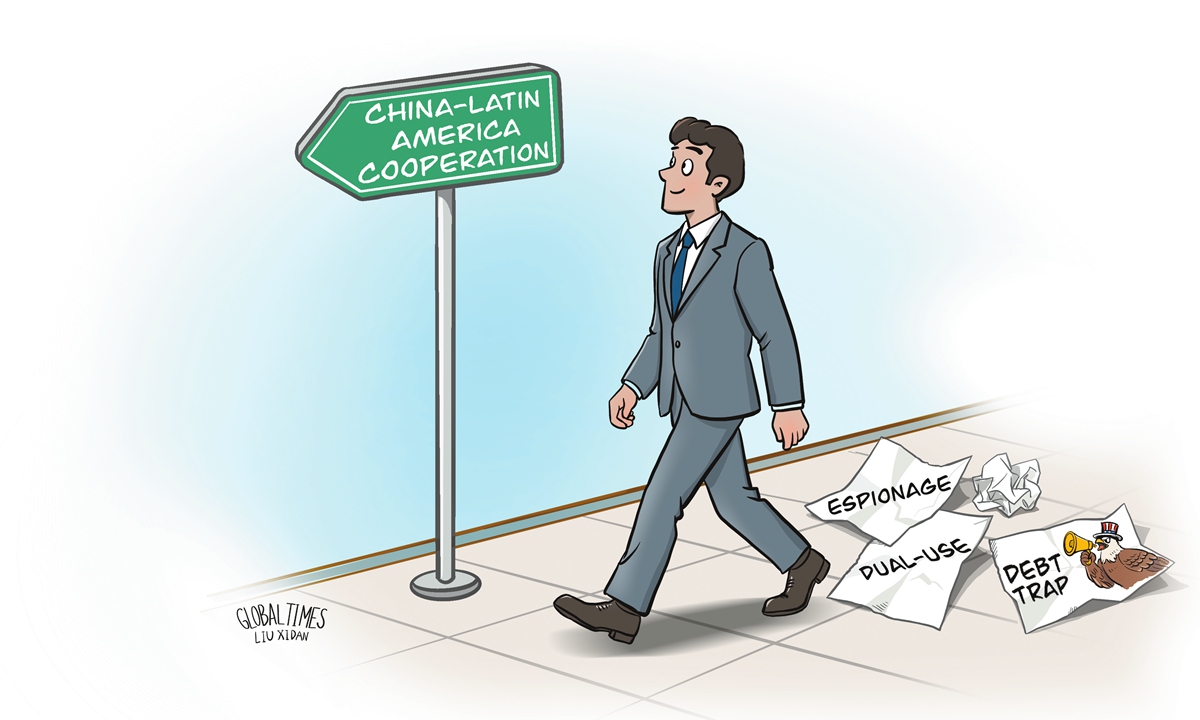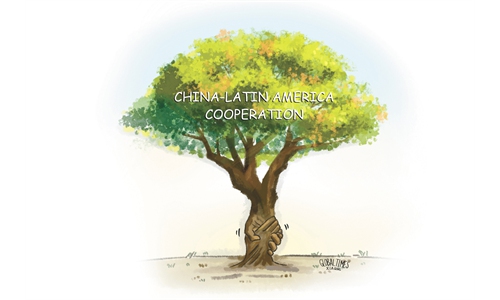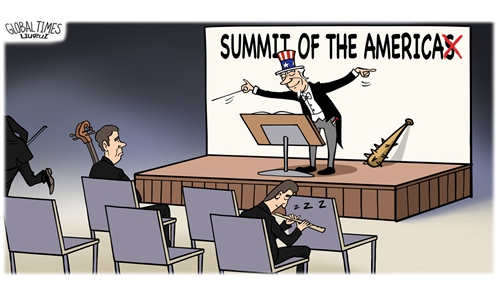Washington’s anti-China narratives debunked by development realities in Latin America

Illustration: Liu Xidan/GT
Last week, Admiral Alvin Holsey, Commander of US Southern Command, hyped over China's expanding cooperation with Latin American countries in the development of space infrastructure. Highlighting the scale of China's involvement, Holsey claimed: "Why is that?... I have to make sure as a combatant commander - what does that mean in the future?"
These remarks are part of a broader pattern in which opinions from Washington speculate that China's infrastructure projects in Latin America and other regions may serve dual purposes - civilian and military.
Beyond the "dual-use" narrative, Washington has propagated several other claims aimed at curbing China-Latin America cooperation. These include allegations of "Chinese espionage" via digital infrastructure and 5G networks, the long-discredited and often-recycled myth of the so-called debt trap, and assertions that China is responsible for Latin America's premature deindustrialization.
In reality, the most significant military presence in Latin America stems not from China but from the US, which maintains over 70 active military installations in the region. Globally, the US operates nearly 800 military bases, underscoring its extensive international military footprint.
The real "debt trap" in Latin America was not forged in Beijing, but in Washington - where, during the 1980s, countries in the region were pushed toward bankruptcy, paving the way for neoliberal reforms imposed by multilateral institutions.
In contrast, infrastructure projects associated with the China-proposed Belt and Road Initiative have played a decisive role not in exacerbating debt burdens, but in repositioning Latin American economies within global value chains - as exemplified by the completion of the Port of Chancay in Peru, widely regarded as a turning point for the region.
Similarly, confirmed episodes of espionage have not come from the East, but from US intelligence agencies. Among the numerous documented cases, the NSA's surveillance of Brazilian President Dilma Rousseff and the state-owned oil company Petrobras - revealed in the early 2010s - remains a striking example of Washington's own record of interference. Meanwhile, Chinese digital services - high in quality and affordable in cost - have contributed significantly to economic progress in Latin America, also helping modernize the region's infrastructure.
As for the narrative of China-induced deindustrialization, it collapses under serious scrutiny. It is widely recognized that Latin America's industrial decline resulted from liberalizing and surrender-driven policies implemented under the framework of the Washington Consensus - initially introduced in the context of external debt renegotiations during the 1980s and 1990s. In contrast, China maintained the strategic role of state-owned enterprises and public ownership within its economy, and in the decades that followed, consolidated itself as a global industrial and technological powerhouse. Agreements with Brazil and other countries in the region make it clear that China is not only a key market for Latin American exports, but also a committed partner in technology transfer, scientific cooperation, educational exchange and productive infrastructure investment. The establishment of a Technology Transfer Center demonstrated China's alignment with Latin America's industrial development goals.
Numerous bilateral and China-CELAC (Community of Latin American and Caribbean States) cooperation agreements now include specific provisions on education and science and technology cooperation. In fact, the very space infrastructure collaboration now criticized by US officials is itself clear proof of the high level of synergy between China's investments and Latin America's ambitions for high-tech development.
Recent events in Beijing have made it clear that while Admiral Holsey and other US officials may question the nature of China's cooperation with Latin America, the countries of the region do not share these doubts. At the Fourth Ministerial Meeting of the China-CELAC Forum, Latin American nations reaffirmed their commitment to deepening cooperation across various sectors, emphasizing multilateralism, mutual trust, peaceful settlement and shared development as the foundations of their engagement with China. Colombia's recent signing of a cooperation plan on jointly building the Silk Road Economic Belt and the 21st-Century Maritime Silk Road and the numerous new China-Brazil agreements resulting from bilateral discussions, reflect this shared vision.
In response to Admiral Holsey's question - "What does that mean in the future?" - perhaps the most compelling answer can be found in the words of Brazilian President Luiz Inácio Lula da Silva, who stated in Beijing just days prior: "China deserves to be regarded with more goodwill and less prejudice. China is a new force in the 21st-century in sectors of economy and technology."
If US policymakers take this message seriously, they may come to realize that cooperation - not confrontation - is the most constructive path forward.
Efforts to resurrect outdated Cold War narratives will find little traction among Latin American societies, and anti-China myths are destined to wither - not merely because they are built on blatant falsehoods, but because they fail entirely to address the region's genuine needs and development aspirations.
The author is a Brazilian commentator on international relations and a PhD candidate in Global Studies at Shanghai University. opinion@globaltimes.com.cn



